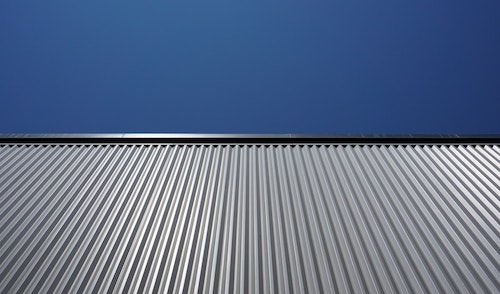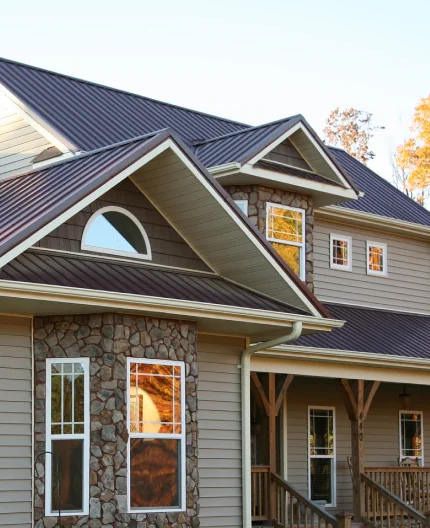Types of Standing Seam Metal Roofs
Published on Wednesday October 13, 2021Standing seam metal roofs are a popular roofing choice for residential, commercial, and industrial projects. This versatile roofing option gives owners many advantages. Expect the initial investment to bring energy savings, a wide scope of design options, durability, impressive longevity, and more.
If you’re trying to choose between the different types of standing seam metal roofs, it’s best to learn exactly what standing seam metal roofs are as well as the advantages and disadvantages of each type.
What are standing seam metal roofs?
Different types of standing seam metal roofs all share one important characteristic: a concealed fastener system. This design features vertical “legs” and a wide, flat area of the metal panel between two legs. This raised seam is what makes this roofing type so popular since it allows for protected fasteners, increased durability, and incredible longevity.
Standing seam metal roofs are most commonly installed vertically, running from eave to ridge of your roof. Since their fasteners are protected and not visible, a lot of people enjoy the visual aspects of standing seam metal roofs but also reap the practical benefits of the design. They are low maintenance and offer high reliability. Standing seam metal roofs can be directly fastened to the decking beneath the versatile leg using a fastener flange or to the roof deck itself using a clip.
There are numerous types of standing seam metal roofs, so expect a wide array of options when you choose a standing seam metal roof for your home.
Types of Standing Seam Metal Roofs

With so many product selections to choose from, the process of deciding what types of standing seam metal roof to use on your home can be overwhelming. Keep in mind that despite the countless types, all of them can be sorted by three main factors: attachment method, panel shape, and how the panels engage with each other.
Attachment Method
This aspect of a standing seam metal roof refers to how the panels are attached to the roof itself. They can attach to the roof decking, rafters, or purlins of the roof. The two main methods of standing seam metal roof attachment are fastening flange and clips.
Fastening Flange
This type of attachment method fixes directly to the roof decking. A fastener is inserted through a slotted flange, then the next panel snaps on top of it to cover the fastening flange as well as the screw.
This type of attachment method is the most economical and easy to install, but the advantages come with some limitations. They aren’t suitable for a roof that requires a weather-tightness warranty or that requires a solid roof deck for proper installation. Lastly, the slotted flange attachment piece limits both contraction and expansion–a natural behavior of metal panels–which means these panels are best suited for smaller projects.
Clip
Clipped attachment methods use a heavy steel clip to latch onto the substructure of the roof. These clips are designed to work with both male and female legs on the panel. Clips can be used over a solid decking or an open frame. Additional advantages include their ability to allow for contraction and expansion, far more than a fastening flange attachment method. This means they are well suited for a wider variety of projects. Weather tightness warranties are also fully possible and even common with standing seam metal roofs using a clip attachment.
Panel Shape
There are a variety of shapes, sizes, and types of standing seam metal roof panels. The biggest difference is the width of the panel and seam height. Differences in these seemingly minor details can have a big impact on the overall performance of your roof.
Width
The width of a standing seam metal panel can vary widely, but finding anything from 12 inches to 18 inches is common and preferred. Anything larger than these widths can negatively impact the performance of your standing seam metal roof. Check with your roofing professional to determine what width is best for your roof and to ensure the validity of your chosen panels’ engineering.
Seam Height
The height of the seam (or the vertical leg) is also important. Sometimes referred to as rib height, the ideal seam height is anywhere from 1 inch to 3 inches, with 1½ and 2 inches being the most popular height. The height difference determines how well your standing seam roof performs, specifically with the uplift in high wind areas or locations that get a lot of storms.
Panel Engagement
The three main engagement methods for standing seam metal panels are snap-locked, mechanically seamed, and batten-locked.
Snap Lock
As its name implies, a snapped connection pulls together male and female legs with a simple snap-in-place method. During the installation process, the legs are aligned beside each other so they can easily be pressed together. Pressure is applied, usually by hand. This pushes the upper panel down into the lower until the legs engage with one another. While snapped engagement styles are often done by hand, a rubber mallet can be used to help the process when necessary.
Mechanically Seamed
This type of standing seam metal roof requires a motorized seaming machine. The installation cannot be effectively completed otherwise. A seaming machine folds two or more panel legs together to create a strong engagement that is weathertight. This connection is much stronger than a snapped engagement style, allowing it to perform well on low-slope roofs, roofs in areas with high winds or regular storms, and in projects that require weathertight warranties.
Batten Lock
This type of standing seam metal roof has two legs of the panels roll-formed, then buttoned beside each other. A metal cap is placed over the legs to create the standing seam. This type of standing seam roof can either be snap-locked or mechanically seamed into place. How it is engaged greatly determines the weather-tightness and durability of your final roof.
Talk to the Roofing Experts
When it comes to a roofing upgrade, a skilled professional can help the project go much smoother. Long Roofing is a preferred service provider for home projects and roofing installations due to our expertise and work quality. Contact us online to get all your roofing questions answered or to schedule your roofing upgrade.
Interested in Long Home Products?
See our special offers now.
*Excludes labor. Subject to credit approval.
**Excludes labor. Subject to credit approval.
One-day installs contingent upon municipal rules and regulations.
By submitting a form, I authorize Long Home to contact me with information about its products and services via mail, email, phone and/or text at the contact information provided, even if I am on the national do not call list. Long Home may use automated telephone technology to initiate calls to its customers. Calls and in person estimates may be recorded for quality and training purposes.







